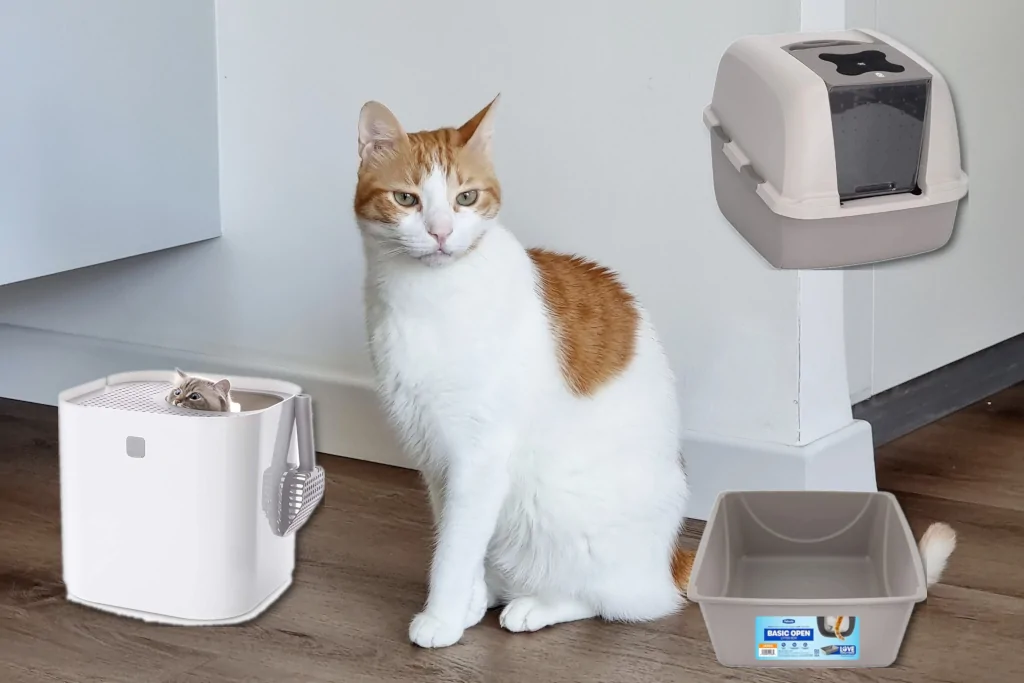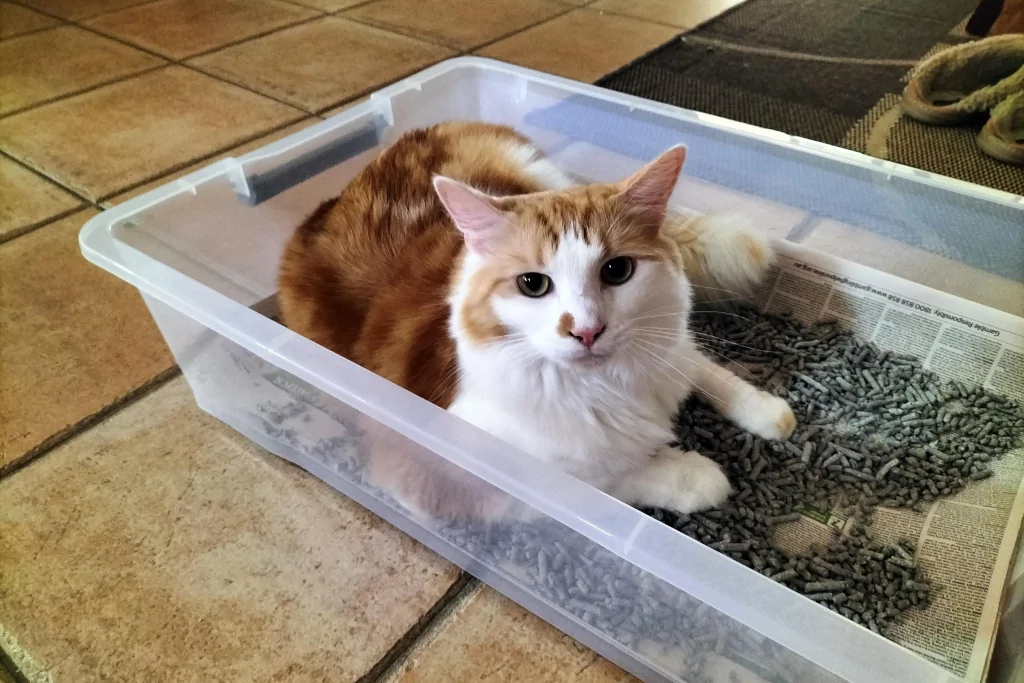Disclosure: We may earn a commission from helpful, relevant links in our content. No cost to you. See our privacy policy.
Struggling with odor control or constant litter tracking? You’re not alone.
Choosing the right litter box setup can be a game-changer for both you and your feline friend.
The key to a clean and happy home for both you and your cat lies in finding the perfect combination of litter box style, location, and litter type.
In this article, we’ll dive into the details of creating the ideal litter box environment, which will have your cat purring with satisfaction and keep your home fresh and tidy.

Litter Box Styles: Which One Is Best for Your Cat?
There’s no one-size-fits-all solution when it comes to litter box styles, as each cat has its preferences. Here are some popular styles and their benefits:
Open Litter Boxes

These are the most common and budget-friendly option. They provide easy access and allow your cat to survey their surroundings while doing their business.
However, they may not provide the best odor control or privacy. To minimize the mess, you can place a litter mat beneath the box to capture any stray litter.
For an open litter box with a sleek design, try the Petmate Open Litter Pan. Its spacious design and raised back help contain litter and keep your floors clean.
Hooded or Covered Litter Boxes

These offer more privacy and better odor control than open boxes. They also help contain litter and prevent your cat from scattering it around the house.
Some cats love the added seclusion, while others may feel confined or trapped. You must ensure the hooded box is large enough for your cat to comfortably move around in.
For easy cleaning, look for models with removable lids, such as the Catit Jumbo Hooded Cat Litter Pan. This one offers plenty of room and a carbon filter to help control odors.
High-sided Litter Boxes

If your cat is an enthusiastic digger, a high-sided litter box might be the answer. It helps contain litter better than open boxes but still offers visibility and easy access for your cat.
Ensure the sides aren’t too high, as this may cause difficulty for older cats or kittens to enter.
Check out the Nature’s Miracle High-Sided Litter Box for a durable and easy-to-clean option with high sides to minimize litter scatter (it’s a bit pricey, though).
For a budget-friendly high-sided litter box option, consider the Van Ness High Sides Cat Litter Pan. This durable and easy-to-clean litter box is an affordable solution to help minimize litter scatter.
Top-entry Litter Boxes

These boxes have a hole on the top, requiring your cat to jump in and out. This design helps reduce litter tracking and provides additional privacy.
However, top-entry boxes may not be suitable for kittens, senior cats, or cats with mobility issues.
For a versatile top-entry box, consider the Modkat Top-Entry Litter Box, which includes a reusable liner and a built-in litter tracking mat.
Automatic Litter Boxes
Automatic litter boxes are designed for convenience and low maintenance. They automatically scoop waste into a separate compartment, reducing the time and effort you spend on cleaning.
These boxes typically use sensors or timers to initiate the cleaning process, ensuring a consistently clean environment for your cat.
They tend to be more expensive and may require specific types of litter or accessories, such as liners or replacement trays. Be sure to check compatibility with your preferred litter type before purchasing.
One popular automatic litter box option is the Litter-Robot 4. This Wi-Fi-enabled, self-cleaning litter box features an automatic sifting system, reducing odors and the need for frequent scooping. While it’s an investment, many cat owners find the convenience and reduced maintenance well worth the cost. Get $25 OFF on Litter Robot 4 with this link.
Our guides:
Here’s the summary table for the types of litter boxes:
| Type | Main Features | Product Recommendation |
| Open Litter Box | Budget-friendly, easy access, less odor control | Petmate Open Litter Pan |
| Hooded Litter Box | More privacy, better odor control, contains litter | Catit Jumbo Hooded Cat Pan |
| High-sided Litter Box | Minimizes litter scatter, good for diggers | Nature’s Miracle / Van Ness |
| Top-entry Litter Box | Reduces litter tracking, offers privacy | Modkat Top-Entry Litter Box |
| Automatic Litter Boxes | Low maintenance, automatically scoops, may require specific litter types | Litter Robot 4 |
To find the best fit for your cat, consider factors such as their age, size, and personal preferences. You might need to experiment with different styles before finding the perfect match.
Location, Location, Location: Finding the Perfect Spot
When it comes to setting up your cat’s litter box, the right location is crucial for both their comfort and your satisfaction. Here are some practical tips to help you find that ideal spot:
- Quiet and Low-Traffic. Cats value their privacy and prefer to do their business in a peaceful area. Choose a location away from busy household activity, loud noises, or constant foot traffic to encourage your cat to use the litter box without feeling stressed or exposed.
- Accessibility. The litter box should be easy for your cat to access at all times. Avoid placing it in a room where doors might accidentally be closed, or in an area where obstacles could block the entrance. If you have a multi-level home, consider placing a litter box on each floor to accommodate senior cats or those with mobility issues.
- Separate from Food and Water. Cats instinctively avoid eliminating near their food and water sources. Maintain a reasonable distance between the litter box and your cat’s feeding area to promote good hygiene and make them feel more at ease.
- Adequate Ventilation. Good airflow is essential for managing odor and maintaining a healthy environment for your cat. Avoid placing the litter box in small, enclosed spaces, such as closets or cabinets, unless they’re well-ventilated.
- Consistency. Once you’ve found the perfect spot, try to keep the litter box in the same location. Frequent changes in location can confuse your cat and lead to accidents or refusal to use the box.
- Multiple Cats. If you have more than one cat, provide a separate litter box for each, plus one extra. This helps prevent territorial disputes and ensures each cat has a comfortable space to do their business. Spread the litter boxes throughout your home to offer more choices and reduce competition.
By carefully considering your cat’s preferences and your home’s layout, you can find the perfect location for their litter box. A well-chosen spot will promote proper litter box usage and make both you and your cat happier in the long run.

Litter Types: Clumping, Non-clumping, and More
Finding the right type of litter is essential to keeping both you and your cat happy. The most common types of cat litter include clumping, and non-clumping, with a few alternative options.
The best option for you will depend on your environment (dry, humid, etc), cat’s preferences, cat mobility, and your habits. Let’s dive into the details of each to help you choose the perfect one.
Clumping Litter
Clumping litter is a popular choice among cat owners due to its convenience and odor control.
Made from sodium bentonite clay, it forms solid clumps when exposed to moisture, making it easy to scoop out and dispose of waste. This type of litter typically lasts longer, as you only need to remove the clumps and top off with fresh litter.
Dr. Elsey’s Ultra Premium Clumping Cat Litter is a highly-rated option that provides excellent odor control and easy clumping for hassle-free cleaning.
When I first adopted my male cat, Smokey, I tried clumping litter, and it made cleaning his litter box a breeze. The litter effectively controlled odor and made scooping out waste a quick and easy task.
Non-Clumping Litter
Non-clumping litter is made from materials like clay or wood shavings that don’t form solid clumps when wet.
This type of litter is usually less expensive than clumping litter, but it requires more frequent replacement, as it becomes saturated with waste over time.
For a non-clumping litter option, consider Tidy Cats 24/7 Performance Scented, available on Chewy. This reliable choice offers consistent odor control and low-dust formula.
Non-clumping litter may be a good option for those who prefer to change the entire litter box more often and don’t mind the added maintenance.
Alternative Litter Options
In recent years, alternative litter materials have gained popularity due to their eco-friendliness and unique properties. Some popular alternative options include:
- Recycled Paper. Made from recycled newspaper or paper pulp, this type of litter is biodegradable and dust-free. It’s a great option for cats with allergies or respiratory issues. Fresh News Unscented is a good option. It’s made from recycled materials and provides excellent absorbency and low dust for sensitive cats.
- Wood or Sawdust Pellets. Derived from wood or sawdust, these pellets are biodegradable and offer excellent odor control. They may not clump as well as clay litter, but they are a more environmentally friendly option. Feline Pine Original Cat Litter is made from 100% natural pine and provides outstanding odor control and absorbency while being eco-friendly.
- Corn or Wheat. Litter made from corn or wheat is biodegradable and clumps well, making it a good alternative to traditional clay litters. It’s also generally dust-free and can be flushed down the toilet in small quantities. World’s Best Cat Litter is a highly recommended biodegradable litter made from corn, offering excellent clumping and odor control.
- Walnut Shells. This type of litter is made from crushed walnut shells, which are highly absorbent and biodegradable. It offers good odor control and clumping, but may not be suitable for cats with nut allergies. The Naturally Fresh Quick-Clumping walnut-based cat litter is highly absorbent, offers good odor control, and clumps well for easy cleaning.
When choosing a litter type, consider your cat’s preferences and your priorities, such as odor control, clumping ability, and eco-friendliness. Experimenting with different types of litter can help you find the best match for your cat and your household.
Making Changes and Transitioning to a New Setup
Transitioning your cat to a new litter box setup, whether it’s a different type of box or a new litter material, requires patience and a gradual approach.
Start by placing the new litter box or litter type alongside the existing setup, allowing your cat to explore and become familiar with it.
Gradually mix the new litter with the old, increasing the proportion of the new material over one to two weeks. Observe your cat’s behavior and adjust the transition speed if they seem hesitant or resistant to change.
Whave an in-depth guide on litter-box training your kitten, as well as litter box training for adult cats. Remember, consistency and patience are key to helping your cat feel comfortable and secure during this process.
FAQs
Alex, a passionate animal lover, has experience in training and understanding animal behavior. As a proud pet parent to two dogs and three cats, he founded AnimalReport.net to share insights from animal experts and expand his knowledge of the animal kingdom.





Your ability to distill complex information into digestible content is remarkable. Thanks for another great post!
Keep it up!